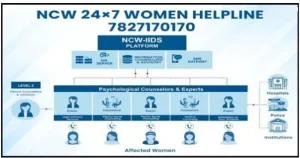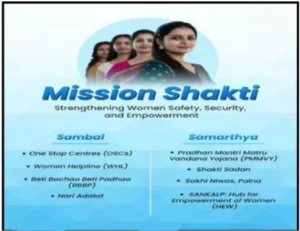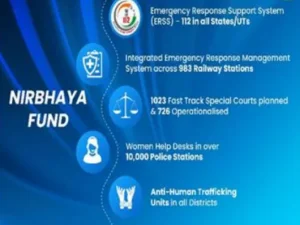A 2025 United Nations femicide report by United Nations Office on Drugs and Crime (UNODC) and UN Women warns that a woman or girl is killed every 10 minutes worldwide, with 83,000 femicides in 2024.
- November 25 marks the International Day for the Elimination of Violence against Women, observed globally to raise awareness, strengthen advocacy, and promote action against violence against women and girls (VAWG).
International Day for the Elimination of Violence against Women
- Date & Significance: Observed on 25 November to raise global awareness about VAWG.
- Global Theme 2025: “UNiTE to End Digital Violence against All Women and Girls”.
- UN Adoption: Established by the United Nations General Assembly in 2000.
- 16 Days Campaign: The 16 Days of Activism Against Gender-Based Violence is an annual global campaign led by UN Women to raise awareness and mobilize action to end VAWG worldwide.
- Duration & Key Dates: The campaign runs every year from 25 Nov to 10 Dec.
- 25 November: International Day for the Elimination of Violence Against Women.
- 10 December: Human Rights Day.
- India’s Efforts: Strengthened legal frameworks, support systems, and measures to address social and digital challenges affecting women and girls.
- Focus Areas: Highlights technology-facilitated VAWG—online harassment, cyberstalking, deepfakes, doxxing, and coordinated misogynistic attacks.
- Objective: Promote prevention, accountability, and collective action by governments, civil society, and individuals.
International Women’s Day (March 8)
- Observed globally, it reaffirms commitment to the welfare, empowerment, and development of women, highlighting persistent concerns of violence against women, especially among marginalized groups.
- Theme for 2025: “For ALL women and girls: Rights. Equality. Empowerment.”
- This theme marks the 30th anniversary of the Beijing Declaration and Platform for Action, urging a renewed commitment to the most progressive blueprint for women’s rights worldwide.
|
Alarming Global Trends Identified by the Report
- Global Femicide crisis: Nearly 60% of women killed in 2024 died at the hands of intimate partners or family members, highlighting the home as the most dangerous site of violence.
- Regional Variations: Africa recorded the highest femicide rate, followed by the Americas, Oceania, Asia and Europe.
- Digital Violence Surge: Rapid technology penetration has intensified cyberstalking, coercive control, deepfakes, doxxing, image-based abuse, often escalating into offline attacks.
- Slow Global Progress: UN agencies note stagnation in prevention efforts, weak justice delivery, and underreporting of femicide and cybercrimes.
- The report called for coordinated prevention efforts, stronger laws, and improved survivor services.
About Femicide
- Definition: Femicide is the intentional killing of a woman or girl with a gender-related motivation, distinct from homicide, where the motive may not be gender-based.
- Drivers: It is primarily driven by discrimination against women and girls, unequal power relations, gender stereotypes, and harmful social norms.
- Occurrence: Femicide can take place at home, in workplaces, schools, or public and online spaces.
- Causes: Common causes include intimate partner violence, sexual harassment and assault, harmful practices, and trafficking.
|
About Violence Against Women and Girls (VAWG)
- United Nations Definition: The violence against women as “any act of gender-based violence that results in, or is likely to result in, physical, sexual, or mental harm or suffering to women, including threats, coercion, or arbitrary deprivation of liberty, whether occurring in public or in private life.”
- Origins of VAWG: It stems from deeply entrenched patriarchal structures, systemic gender inequality, and persistent social discrimination, all of which restrict women’s autonomy and freedoms in both private and public spheres.
- Patriarchal Social Structures: Violence is rooted in historical and cultural acceptance of male dominance and control over women.
- Gender Inequality: Unequal power relations, discriminatory norms, and restrictive gender roles normalise coercion and silence resistance.
- Cultural Practices: Harmful traditions and social customs reinforce women’s subordination and justify violence, often presenting it as “family honour” or community norms.
- Lack of Awareness and Weak Institutional Response: Limited legal enforcement, social stigma, and fear of retaliation prevent survivors from seeking justice, allowing cycles of abuse to continue unchallenged.
- Forms of Violence Against Women: The UN definition underscores that VAWG is not limited to physical acts alone but includes a broad spectrum of psychological, sexual, and structural harms.
 Intimate Partner and Domestic Violence: Includes physical assault, sexual coercion, emotional manipulation, and controlling behaviour by partners or family members.
Intimate Partner and Domestic Violence: Includes physical assault, sexual coercion, emotional manipulation, and controlling behaviour by partners or family members.
- Example: The UN notes that in 2023, a woman was killed or harmed every 10 minutes by someone within her home environment.
- Sexual Violence: Covers rape, sexual assault, harassment, trafficking, forced prostitution, and conflict-related sexual violence.
- In India alone, over 31,000 rape cases were reported in 2022, reflecting the scale of the crisis.
- Psychological and Cultural Abuse: Involves humiliation, threats, verbal aggression, financial control, isolation, and emotional degradation.
- Harmful practices such as female genital mutilation, child marriage, witch-branding, widowhood rituals, menstruation-related exclusion, and female infanticide exemplify culturally sanctioned psychological violence.
- Technology-Facilitated Violence: Encompasses cyberstalking, digital harassment, deepfake pornography, online defamation, and doxing.
- With increasing digital presence, women—especially activists, journalists, and public figures—face heightened online risks.
- Impacts of VAWG: VAWG is recognised globally as one of the most pervasive human rights violations, affecting women across age, class, geography, and culture.
- Physical and Mental Health Consequences: Women suffer from injuries, chronic illnesses, reproductive health issues, and long-term mental trauma including depression, anxiety, and Post-Traumatic Stress Disorder (PTSD).
- The emotional burden often leads to isolation and withdrawal from daily activities.
- Social and Psychological Effects: VAWG reinforces cycles of inequality, normalises fear, and limits women’s mobility, autonomy, and participation in social and community life.
- As feminist scholar Gerda Lerner notes, the acceptance of male domination allows violence to remain invisible and unchallenged.
- Economic Impact: Violence restricts women’s ability to work, reduces productivity, and imposes healthcare and legal costs.
- The World Bank estimates a global loss of 2% of GDP (~$1.5 trillion) due to VAWG. In India, where women account for only 25.1% of the workforce, violence is a major barrier to economic empowerment.
- Developmental Impact: VAWG undermines progress toward gender equality, education, poverty reduction, and social justice.
- A society cannot advance when half its population is burdened with insecurity, trauma, and restricted opportunity.
Need for Women’s Safety in India
- Persistent Violence: High levels of domestic and sexual violence continue despite stronger legal frameworks, exposing gaps in implementation and accountability.
- Despite legal strengthening, 4,48,211 crimes against women were reported in 2023, with cruelty by husbands/relatives (IPC 498A) remaining the largest category, underscoring continued domestic abuse (NCRB, 2023).
- Deep-Rooted Patriarchy: Patriarchal norms, early marriage, dowry practices, and rigid gender roles perpetuate entrenched cycles of violence and discrimination.
- The persistence of gendered violence is reflected in the fact that 31.2% of ever-married women aged 18-49 have experienced spousal violence in their lifetime, demonstrating the deep-rooted nature of patriarchal control (NFHS-5, 2019-21).
- Rising Digital Risks: Greater smartphone use and misuse of AI, deepfakes, and online blackmail have expanded women’s vulnerability in digital spaces.
- The surge in online threats is confirmed by the National Cybercrime Reporting Portal (NCRP), which has recorded a more than doubling of cybercrimes against women in recent years, expanding their vulnerability to AI-enabled abuse and blackmail.
- Underreporting & Barriers: Stigma, fear of retaliation, low awareness, and institutional apathy discourage reporting and delay justice.
- Institutional gaps are severe, the court pendency rate for crimes against women reached 90.8% in 2023, while the conviction rate remains low, contributing to underreporting and delayed justice (NCRB, 2023).
- Economic Consequences: Violence reduces female labour force participation, undermines productivity, disrupts education, and weakens overall socio-economic development.
- Violence severely restricts economic participation, with the female labour force participation rate (FLFPR) remaining around 40.3% in 2024, mirroring the global cost where VAWG accounts for up to a 2% loss of GDP (PLFS, 2024 & World Bank).
Constitutional Provisions for Women’s Protection
- Equality Before Law (Article 14): Grants equal rights and opportunities to men and women in political, economic, and social spheres.
- Prohibition of Discrimination (Article 15): Forbids discrimination based on sex, religion, caste, or race; Article 15(3) allows affirmative action for women.
- Equality of Opportunity (Article 16): Ensures equal access to public employment for all citizens.
- Right to Livelihood (Article 39(a)) & Equal Pay (Article 39(c)): Promotes economic equality and fair remuneration for equal work.
- Workplace Justice (Article 42): Mandates humane work conditions and maternity relief.
- Fundamental Duty (Article 51(A)(e)): Obligates citizens to renounce practices derogatory to women’s dignity.
India’s Key Measures for Women’s Safety
Strengthened Legal Framework
- Bharatiya Nyaya Sanhita (BNS), 2023: Introduces significantly stricter punishments for sexual offences, including life imprisonment for rape of minors under 18 years.
- Mandates audio–video recording of victim and witness statements to enhance transparency.
- Prioritises time-bound investigation and trial, especially in cases involving women and children.
- Protection of Women from Domestic Violence Act (PWDVA), 2005: Provides a comprehensive definition of domestic violence.
- As per the Act, domestic violence means an “aggrieved person” as any woman who is, or has been, in a domestic relationship with the respondent.
- Section 3 defines it as any act that harms a woman’s physical or mental health or endangers her safety, including harassment for unlawful demands. The term “domestic violence” includes:
- Physical abuse (harm, injury, or threat)
- Sexual abuse (any non-consensual or humiliating sexual act)
- Verbal / emotional abuse (insults, threats, humiliation)
- Economic abuse (withholding money, denying access to resources, disposing of property)
- Dowry-related harassment or coercion for property / dowry
- Ensures civil remedies including protection orders, residence rights, monetary relief, and child custody arrangements.
- Prevention of Sexual Harassment at Workplace Act (POSH Act), 2013: Makes it compulsory for establishments with over 10 employees to constitute an Internal Committee (IC).
- Establishes Local Committees for women in the unorganised, domestic and informal sectors.
- Sets a 90-day timeline for completing inquiries, ensuring swift redressal.
- Criminal Law (Amendment) Act, 2018: Enhances punishment for rape, including provisions for aggravated child sexual abuse under POCSO.
-
- Strengthens timelines for investigation and trial to reduce pendency.
Institutional and Support Mechanisms

- National Commission for Women (NCW): Serves as the statutory watchdog for safeguarding women’s rights.
- It receives complaints of violence and rights violations against women (both in writing and online) through its portal.
- Runs an online complaint system and a 24×7 helpline (7827170170) for cyber harassment and other forms of abuse.
- The portal is driven by Interactive Voice Response (IVR) mechanism through Digital India, in collaboration with the Ministry of Electronics and Information Technology.
- Most states have also constituted State Commissions for Women (SCWs) with parallel responsibilities.
 Mission Shakti (Sambal & Samarthya): A comprehensive umbrella scheme integrating safety, security, empowerment and rehabilitation across a woman’s life cycle.
Mission Shakti (Sambal & Samarthya): A comprehensive umbrella scheme integrating safety, security, empowerment and rehabilitation across a woman’s life cycle.
- Ensures coordinated functioning of multiple protection and support services.
- One Stop Centres (OSCs): Operate as district-level integrated support facilities.
- Provide medical assistance, police facilitation, legal aid, temporary shelter, and psychosocial counselling under one roof.
- The Ministry of Women and Child Development also implemented the OSCs Scheme with effect from April 01, 2015.
- Swadhar Greh Scheme: Offers shelter, counselling, vocational training and long-term rehabilitation to women in difficult circumstances.
 The Ministry of Women and Child Development is implementing the Swadhar Greh Scheme, revised with effect from April 01, 2016.
The Ministry of Women and Child Development is implementing the Swadhar Greh Scheme, revised with effect from April 01, 2016.
- Stree Manoraksha Project: The Ministry of Women and Child Development has engaged the services of National Institute of Mental Health and Neuro Sciences (NIMHANS) in Bengaluru for providing basic and advanced training under project ‘Stree Manoraksha’ to the staff of OSCs across the country.
- Focuses on strengthening mental health and trauma response capacities of OSC staff.
- Ensures improved psychosocial support for survivors.
Digital and Emergency Support Systems

- Women Helpline (181): A 24×7 emergency helpline providing immediate assistance and referral to relevant agencies.
- Emergency Response Support System (ERSS–112) under the Nirbhaya Fund: A unified national emergency number integrating police, fire and medical services for quicker interventions.
- Digital Shakti Campaign: Implemented by the National Commission for Women, a pan India project aimed at digitally empowering and skilling women and girls.
- WhatsApp Emergency Line (7217735372): A rapid-response contact mechanism used extensively during the COVID-19 lockdown and continues for urgent interventions.
Technology-Enabled Enforcement Tools
- Investigation Tracking System for Sexual Offences (ITSSO): Monitors statutory investigation timelines in rape and POCSO cases.
- Ensures police compliance and reduces delays.
- National Database on Sexual Offenders (NDSO): A centralised digital registry of convicted sexual offenders.
- Used by law enforcement for background checks and preventive surveillance.
- Crime Multi-Agency Centre (Cri-MAC): Facilitates real-time information sharing on heinous crimes, missing persons and offenders across police agencies.
Fast-Track Justice and Police Responsiveness
- Fast Track Special Courts (FTSCs): India has 773 FTSCs, including 400 dedicated e-POCSO courts (as of 2025).
- These courts have disposed of over 3.34 lakh sexual offence cases, significantly reducing pendency.
- Women Help Desks in Police Stations: Over 14,658 Women Help Desks set up across police stations.
- Provide gender-sensitive reporting, counselling, and referral to OSCs and legal/medical services.
- SHe-Box Portal: Launched by the Ministry of Women and Child Development, a single-window POSH platform that lets women file and track workplace sexual-harassment complaints online, auto-routes them to the relevant Internal Committees (ICs) and Local Committees (LCs), and maintains a central database of committees.
- It also mandates a Nodal Officer in every organisation, ensuring quick updates and faster redressal.
Challenges that need to be Tackled
- Underreporting & Social Stigma: Fear of retaliation, honour pressures, and low institutional trust lead to severe underreporting of both offline and online violence.
- Most cases remain hidden. Only 32% of married women report violence (NFHS-5), far higher than official complaints, showing fear and social pressure to silence victims.
- Weak Implementation & Institutional Gaps: Uneven enforcement of gender laws, shortage of POSH ICs/LCs, and limited capacity among police, prosecutors, cyber cells, and counsellors delay justice.
- Institutions struggle to enforce protections; NCW received 12,648 complaints by mid-2024, highlighting gaps in daily enforcement.
- Delayed Justice & Poor Forensics: High court pendency, slow cybercrime investigations, and inadequate district-level cyber-forensic labs hinder effective legal action.
- Judicial backlogs continue to impede justice. Fast Track Special Courts (FTSCs) remain operational (773 as of August 2025), yet the Supreme Court’s high pendency reflects the broader challenge of timely resolution in the judiciary (Lok Sabha/SC Observer, 2025).
- Escalating Digital Violence: Rapid rise in cyberstalking, doxing, gendered disinformation, non-consensual image sharing, and targeted harassment—especially against women in public life.
- Online abuse is rising sharply; 339 cybercrime complaints in 2024 and threats to women journalists show digital spaces are increasingly unsafe.
- AI-Enabled Abuse Outpacing Regulation: Proliferation of deepfakes, synthetic imagery, anonymity tools, and algorithmic amplification makes digital abuse easier to create, harder to detect, and difficult to prosecute.
- One study found a 1,325% rise (2023-2024) in harmful AI-generated abuse, such as deepfakes, showing that sophisticated, easily created digital content is rapidly outstripping existing laws and enforcement capabilities (Childlight Institute, 2024).
- Platform Impunity & Weak Governance: Limited platform accountability, inconsistent content moderation, and absence of harmonised global norms allow cross-border abuse to flourish.
- Inadequate Survivor-Centric Support: Poor access to mental health care, legal aid, long-term shelters, vocational rehabilitation, and digital-safety assistance weakens survivor recovery.
- While 802 One Stop Centres (OSCs) are now operational (as of March 2025), these crucial centres frequently suffer from inadequate funding, staff salary delays (as seen in Kerala in late 2024), and a lack of vehicles, which severely hinders their ability to provide the mandated multi-sectoral assistance.
Way Forward
- Strengthen Legal Frameworks: Update and harmonise laws to specifically address technology-facilitated gender-based violence, including cyberstalking, doxing, online harassment, and deepfakes, as suggested by UN Women’s Call for Global Action.
- Doxing refers to the act of publicly revealing or publishing private, personal, or identifying information about an individual without their consent, typically with the intention to harass, intimidate, or harm them.
- Enhance Institutional Capacity: Train police officers, public prosecutors, cyber cells, and counsellors in handling both offline and digital violence against women and girls; establish district-level cyber-forensic laboratories.
- Regulate Platforms and Artificial Intelligence Tools: Impose robust accountability on social media platforms and artificial intelligence developers, enforce content moderation standards, and regulate algorithmic amplification to prevent abuse.
- Promote Survivor-Centric Support: Expand access to mental health services, legal aid, long-term shelters, vocational rehabilitation, and digital-safety guidance for survivors.
- Invest in Prevention and Digital Literacy: Launch community awareness programs, online safety campaigns, and digital literacy initiatives to empower women and girls to recognise and respond to abuse.
- Global Cooperation and Standards: Align with the Convention on the Elimination of All Forms of Discrimination Against Women (CEDAW), UNESCO Artificial Intelligence ethics recommendations; foster cross-border cooperation for reporting, investigation, and prosecution of transnational digital crimes.
- Protect Women in Public Life: Provide special safeguards for women in politics, media, business, and leadership, including rapid-response mechanisms against coordinated harassment, deepfakes, and disinformation.
Conclusion
Despite India’s progress in laws, digital tools, and survivor support, violence against women persists. Achieving SDG 5 (Gender Equality) requires societal change, institutional accountability, and safe, inclusive spaces to ensure equality, empowerment, and freedom from fear.
![]() 26 Nov 2025
26 Nov 2025

 Intimate Partner and Domestic Violence: Includes physical assault, sexual coercion, emotional manipulation, and controlling behaviour by partners or family members.
Intimate Partner and Domestic Violence: Includes physical assault, sexual coercion, emotional manipulation, and controlling behaviour by partners or family members.

 Mission Shakti (Sambal & Samarthya): A comprehensive umbrella scheme integrating safety, security, empowerment and rehabilitation across a woman’s life cycle.
Mission Shakti (Sambal & Samarthya): A comprehensive umbrella scheme integrating safety, security, empowerment and rehabilitation across a woman’s life cycle.
 The Ministry of Women and Child Development is implementing the Swadhar Greh Scheme, revised with effect from April 01, 2016.
The Ministry of Women and Child Development is implementing the Swadhar Greh Scheme, revised with effect from April 01, 2016. 


